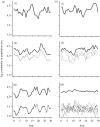Linking biodiversity and ecosystems: towards a unifying ecological theory
- PMID: 20008385
- PMCID: PMC2842700
- DOI: 10.1098/rstb.2009.0155
Linking biodiversity and ecosystems: towards a unifying ecological theory
Abstract
Community ecology and ecosystem ecology provide two perspectives on complex ecological systems that have largely complementary strengths and weaknesses. Merging the two perspectives is necessary both to ensure continued scientific progress and to provide society with the scientific means to face growing environmental challenges. Recent research on biodiversity and ecosystem functioning has contributed to this goal in several ways. By addressing a new question of high relevance for both science and society, by challenging existing paradigms, by tightly linking theory and experiments, by building scientific consensus beyond differences in opinion, by integrating fragmented disciplines and research fields, by connecting itself to other disciplines and management issues, it has helped transform ecology not only in content, but also in form. Creating a genuine evolutionary ecosystem ecology that links the evolution of species traits at the individual level, the dynamics of species interactions, and the overall functioning of ecosystems would give new impetus to this much-needed process of unification across ecological disciplines. Recent community evolution models are a promising step in that direction.
Figures




References
-
- Armsworth P. R., Roughgarden J. E.2003The economic value of ecological stability. Proc. Natl Acad. Sci. USA 100, 7147–7151 (doi:10.1073/pnas.0832226100) - DOI - PMC - PubMed
-
- Balvanera P., Pfisterer A. B., Buchmann N., He J. S., Nakashizuka T., Raffaelli D., Schmid B.2006Quantifying the evidence for biodiversity effects on ecosystem functioning and services. Ecol. Lett. 9, 1146–1156 (doi:10.1111/j.1461-0248.2006.00963.x) - DOI - PubMed
-
- Baumgärtner S.2007The insurance value of biodiversity in the provision of ecosystem services. Nat. Resour. Model. 20, 87–127
-
- Bell G.2007The evolution of trophic structure. Heredity 99, 494–505 (doi:10.1038/sj.hdy.6801032) - DOI - PubMed
-
- Brown J. H., Gillooly J. F., Allen A. P., Savage V. M., West G. B.2004Toward a metabolic theory of ecology. Ecology 85, 1771–1789 (doi:10.1890/03-9000) - DOI
Publication types
MeSH terms
LinkOut - more resources
Full Text Sources
Other Literature Sources

